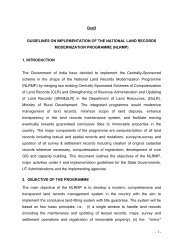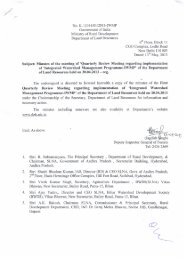Uttarakhand - Department of Land Resources
Uttarakhand - Department of Land Resources
Uttarakhand - Department of Land Resources
Create successful ePaper yourself
Turn your PDF publications into a flip-book with our unique Google optimized e-Paper software.
already constrained due to mountainous terrain, low temperatures and short growing<br />
seasons, with climate change compounding these factors.<br />
Impact on energy supply and demand: With over a billion people, India today only<br />
produces 660 billion KWh <strong>of</strong> electricity and over 600 million Indians, a population<br />
equal to the combined population <strong>of</strong> USA and EU, have no access to electricity, and<br />
limited access to other clean, modern fuels such as LPG and kerosene (GoI, 2007).<br />
The expansion needed in the energy systems, in a climate-constrained world,<br />
represents an enormous challenge for the country but also an opportunity to promote<br />
sustainable development. Renewable energy options existing in <strong>Uttarakhand</strong> are<br />
primarily micro hydro, solar energy, biomass for electricity generation, bio-energy,<br />
especially bio-fuels for transport sector and biogas for cooking.<br />
Impact on forests and biodiversity: Changes in climate could alter the<br />
configuration and productivity <strong>of</strong> the forests ecosystems. Rising temperature,<br />
changes in availability <strong>of</strong> water, and enriched CO 2 are expected to bring significant<br />
changes in species composition in approximately one third <strong>of</strong> the forests worldwide.<br />
Nearly 200,000 villages in India depend on forests for their livelihood. Climate<br />
change is likely to affect forest biodiversity and cause a shift in forest boundaries<br />
thereby impacting the supply <strong>of</strong> forest products and consequently forest-based<br />
livelihoods.<br />
Forest ecosystems in <strong>Uttarakhand</strong> are already subjected to socio-economic<br />
pressures leading to forest degradation and climate change can significantly affect<br />
the availability <strong>of</strong> forest goods and services in terms <strong>of</strong> quality and quantity.<br />
Production <strong>of</strong> several indigenous herbs and forest species in the state is likely to be<br />
severely impacted by these changes. Many Non-Wood Forest Products (NWFPs)<br />
are likely to be more vulnerable to changes in climate system than timber and fuel<br />
wood production and hence would have a more serious impact on NWFPdependent<br />
forest communities.<br />
Impacts on human health: Climate change can directly impact human health due<br />
to mortality and morbidity related to extreme events such as droughts, floods,<br />
cyclones, temperature extremes, etc. or indirectly due to change in transmission<br />
107
















